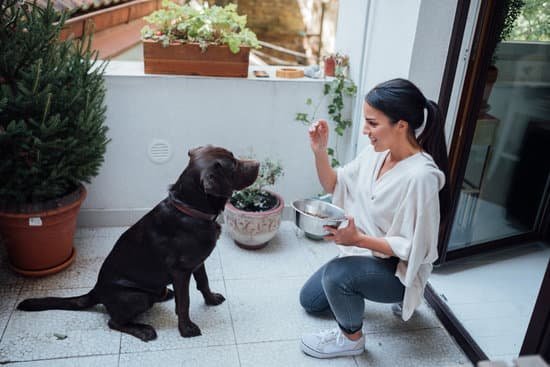Having a dog can be a wonderful addition to a family, especially when it comes to children. However, without proper training and guidance, interactions between dogs and children can result in harm or misunderstandings. Understanding the importance of properly training dogs around children is key to fostering a safe and harmonious relationship within the household. When trained properly, dogs can be harmless companions that bring joy and valuable lessons to children.
One of the significant benefits of having a dog around children is the emotional support they provide. Dogs are known for their unconditional love and loyalty, which can have a positive impact on a child’s mental well-being. Additionally, dogs serve as companions who can teach empathy, responsibility, and patience to children as they care for their furry friends. Moreover, dogs offer educational opportunities as they encourage learning through play and interaction.
Before introducing a dog into a household with children, there are essential factors to consider. These include the breed’s characteristics and temperament suited for children, the age of the child, and the family’s lifestyle. It is crucial to choose a breed known for its gentle nature around kids and ensure that both the dog and child are comfortable with each other. Proper introductions, supervision, and creating boundaries are vital in establishing a positive relationship between dogs and children.
Benefits of Having a Dog Around Children
Having a dog around children can offer a myriad of benefits beyond just being a lovable pet. Dogs provide emotional support to children, offering a sense of security and comfort. The unconditional love and loyalty that dogs display can help children build self-esteem, reduce anxiety, and cope with stress. In addition, the companionship that a dog provides can help children develop social skills, empathy, and responsibility as they learn to care for another living being.
Furthermore, having a dog around can also present numerous educational opportunities for children. From learning about different breeds, basic animal care, and responsible pet ownership to understanding non-verbal communication cues from animals, having a dog in the household can be a source of valuable lessons for children. Additionally, involving children in training exercises and activities with the family dog can teach them patience, consistency, and problem-solving skills.
Not only do dogs offer emotional support, companionship, and educational opportunities for children, but they also promote physical activity through playtime and outdoor exercise. Playing fetch or going for walks with the family dog encourages kids to be more active and can contribute to their overall health and well-being.
This active interaction between dogs and children not only benefits the child’s physical health but also strengthens the bond between them. When trained properly dog children interaction becomes enjoyable for both parties involved.
Factors to Consider Before Introducing a Dog to a Household With Children
Family’s Lifestyle and Schedule
One important factor to consider before introducing a dog to a household with children is the family’s lifestyle and schedule. Dogs require time, attention, and care, so it is essential to assess whether the family has the capacity to meet these needs. Consider how active your family is, how much time you can dedicate to training and exercising the dog, and if there are any allergies or phobias within the household.
Space and Safety Precautions
The size of your living space and safety precautions are also crucial considerations when bringing a dog into a household with children. Make sure that you have enough room for both the dog and children to move around comfortably. Additionally, childproofing your home is necessary to prevent any accidents or conflicts between the dog and children. Secure areas where the dog can retreat if needed, such as a crate or designated space.
Children’s Age and Temperament
The age of your children and their temperament play a significant role in determining whether a particular dog breed is suitable for your household. Younger children may not understand boundaries as well as older ones, so it is important to choose a breed known for its patience and tolerance towards kids. Additionally, educate your children on how to properly interact with dogs – teaching them about respecting the dog’s space, reading body language, and handling interactions gently.
By carefully considering these factors before introducing a dog into your household with children, you can help ensure a safe and harmonious relationship between your furry friend and little ones. Remember that with proper training, supervision, and understanding of both your dog’s behavior and your children’s needs can lead to a happy and healthy environment for all.
Choosing the Right Breed
When considering adding a new furry member to your family, especially when children are involved, it is crucial to choose the right breed of dog. Not all dogs are suitable for households with kids, and selecting a breed with the appropriate characteristics and temperament is essential for ensuring a harmonious environment. While any dog can be harmless when properly trained around children, some breeds naturally have traits that make them more compatible with younger family members.
One important factor to consider when choosing a dog breed for children is the size of the dog. Larger breeds, such as Golden Retrievers or Labrador Retrievers, are known for their gentle nature and patience, making them great companions for kids. These breeds are typically tolerant of the sometimes rough play that can come from children. On the other hand, smaller breeds like Beagles or Pugs can also be good choices due to their manageable size and playful personalities.
Another consideration when selecting a dog breed for children is the energy level of the breed. High-energy dogs like Border Collies or Boxers may require more exercise and mental stimulation than some families can provide. Opting for a breed with a moderate energy level, such as Cavalier King Charles Spaniels or Basset Hounds, could be better suited for households with young children who may not have as much time to dedicate to extensive exercise routines.
| Size | Recommended Breeds |
|---|---|
| Large | Golden Retrievers, Labrador Retrievers |
| Small | Beagles, Pugs |
Training Tips for Dogs Around Children
Proper training is essential when it comes to having dogs around children. Not only does it ensure the safety of both the dog and the child, but it also helps in building a harmonious relationship between them. With the right techniques and consistency, dogs can be great companions for children. Here are some training tips that can help in creating a positive and safe environment for kids and dogs to coexist peacefully:
- Socialization: Introducing your dog to various people, environments, and experiences early on in their life can help in shaping their behavior around children. This exposure will help them feel more comfortable and less anxious when interacting with kids.
- Obedience Training: Teaching your dog basic commands such as sit, stay, come, and leave it is crucial when kids are around. These commands can be used to redirect your dog’s behavior if they become too excited or overwhelmed during playtime.
- Setting Boundaries: Establishing boundaries for both the dog and the child is important to prevent any unwanted behaviors or accidents. Teach children how to properly interact with the dog, such as not pulling on their ears or tail, respecting their space while eating, and recognizing signs of discomfort or stress.
When trained properly using positive reinforcement methods, dogs can be harmless around children. It’s important to remember that every dog is different, so patience and consistency are key when implementing these training tips. By providing a structured environment with clear rules and expectations, you can create a safe and enjoyable relationship between your dog,children.
Remember that training can take time, so don’t get discouraged if progress is slow at first. Seek professional help from a certified dog trainer if needed, especially if you have concerns about your dog’sbehavior around children. Ultimately, a well-trained dog living harmoniously with children can bring joy and companionship to the entire family.
Common Misconceptions About Dogs and Children
Dogs and children can have a wonderful relationship, but there are unfortunately many common misconceptions that may create fear or hesitation in parents considering bringing a dog into their home. It is important to address these myths and concerns to help families understand how dogs can be harmless when trained properly around children.
To debunk these myths, let’s take a look at some of the most prevalent misconceptions about dogs and children:
- Myth: All dogs are aggressive towards children
- Myth: Dogs will always bite or harm young kids
- Myth: Children should never be left alone with a dog
These misconceptions often stem from isolated incidents or lack of proper training and supervision. In reality, with the right approach, dogs can provide numerous benefits to children without posing any harm. By understanding these myths and addressing them head-on, families can feel more confident in introducing a dog into their household.
It is essential for parents to educate themselves about responsible pet ownership and the proper ways to train and socialize a dog around children. By providing clear boundaries, setting expectations, and supervising interactions, parents can help foster a safe and harmonious relationship between their dog and their children. With the right guidance and training, dogs can become an integral part of a child’s life, offering emotional support, companionship, and valuable learning experiences.
The Role of Parents in Ensuring a Safe and Harmonious Relationship Between Dogs and Children
Parents play a crucial role in ensuring a safe and harmonious relationship between dogs and children. It is essential for parents to understand the importance of properly training dogs around children, as this not only benefits the well-being of the child but also the dog. By being actively involved in the training process, parents can create a positive environment where both the child and the dog feel comfortable and secure.
One of the key factors that parents need to consider is setting clear boundaries and rules for both the children and the dog. This includes teaching children how to interact with dogs respectfully, such as not disturbing them while they are eating or sleeping, or understanding when a dog needs space. Additionally, parents should supervise interactions between dogs and children, especially during the initial stages of introducing them to each other.
Furthermore, educating children about dog behavior and body language can help prevent misunderstandings or potential conflicts. Teaching children how to recognize signs of fear or aggression in dogs can prevent accidents from happening. By fostering a sense of mutual respect and understanding between dogs and children, parents
| Role of Parents in Ensuring Safety | Benefits |
|---|---|
| Create positive environment | Comfortable and secure interactions |
| Set clear boundaries/rules | Respectful interaction between kids/dogs |
| Educate on body language/behavior | Prevent misunderstandings/conflicts |
Case Studies and Success Stories
When it comes to the safety and well-being of children, ensuring that dogs are properly trained around them is essential. With the right training and guidance, dogs can be harmless companions for children, providing emotional support, companionship, and even educational opportunities. Allowing children to grow up alongside a well-trained dog can create lasting memories and foster a special bond that will benefit both the child and the pet.
One real-life example of successful training is the story of Bella, a Golden Retriever who was introduced to a household with three young children. Through consistent socialization and obedience training, Bella quickly adapted to her new environment and became a beloved member of the family. Her gentle demeanor and patience with the children not only provided them with comfort but also taught them valuable lessons in responsibility and empathy towards animals.
Another inspiring case study is Max, a Labrador mix who was adopted into a family with teenagers who had never owned a dog before. With proper guidance from an experienced trainer, Max was able to learn boundaries and respect towards the children in the household.
Over time, he not only formed strong bonds with each family member but also showcased his intelligence by participating in educational activities like agility training with the kids. Through these success stories, it is evident that with dedication and patience, any dog can be trained to interact safely and positively with children.
Conclusion
In conclusion, it is evident that dogs can be harmless when trained properly around children. By understanding the importance of training and socializing dogs, parents can provide emotional support, companionship, and educational opportunities for their children through their furry friends. While there are factors to consider before introducing a dog into a household with children, such as choosing the right breed with suitable characteristics and temperament, the benefits of having a well-trained dog far outweigh any challenges.
Training tips for dogs around children, such as socialization, obedience training, and setting boundaries, play a crucial role in ensuring a safe and harmonious relationship between pets and kids. It is essential for parents to take an active role in supervising interactions between their children and dogs to prevent any potential misunderstandings or accidents. By debunking common misconceptions about dogs and addressing concerns proactively, families can create a positive environment where both dogs and children can thrive together.
As demonstrated through case studies and success stories of dogs who have been successfully trained to interact with children, responsible pet ownership is key in fostering a loving bond between animals and kids. By recognizing the potential benefits of having a well-trained dog around children and emphasizing the importance of proper training techniques, families can create lasting memories and experiences that enrich the lives of both pets and humans alike.
Remember, with patience, dedication, and guidance from responsible pet owners, dogs can truly be harmless companions for children to grow up alongside.
Frequently Asked Questions
Can Dogs Be Trained to Be Good With Kids?
Dogs can definitely be trained to be good with kids through proper socialization and obedience training. Teaching commands like “sit,” “stay,” and “leave it” can help create a well-behaved and child-friendly dog.
Can You Train a Dog to Protect Children?
It is possible to train a dog to protect children, but it requires specialized training from professionals. With the right guidance, dogs can learn how to alert their owners if they sense danger or protect them in threatening situations.
Is Training a Dog Like Raising a Child?
Training a dog is not exactly like raising a child, but there are some similarities. Both require consistent discipline, positive reinforcement, and clear communication. However, dogs have different needs and instincts that should be taken into consideration during training.

Welcome to the blog! I am a professional dog trainer and have been working with dogs for many years. In this blog, I will be discussing various topics related to dog training, including tips, tricks, and advice. I hope you find this information helpful and informative. Thanks for reading!





